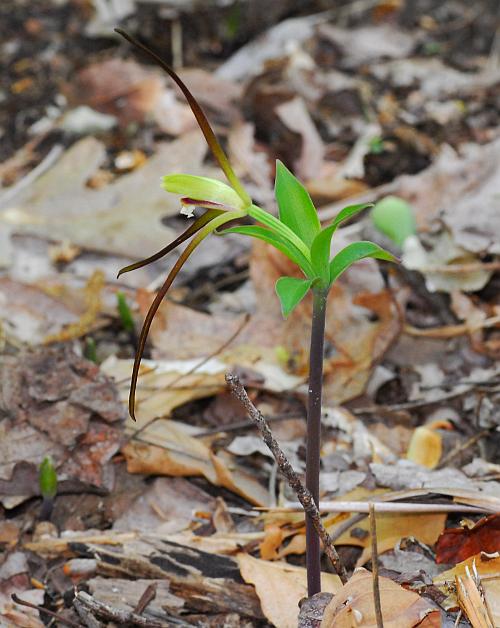Isotria verticillata (Muhl. ex Willd.) Raf.
Large Whorled Pogonia

Native
CC = 10
CW = 3
MOC = 5
© SRTurner
Isotria verticillata (Muhl. ex Willd.) Raf.Large Whorled Pogonia | |
 |
Native CC = 10 CW = 3 MOC = 5 |
© SRTurner |
|
Family - Orchidaceae Habit - Perennial forb, lacking rhizomes, the roots fascicled from the base of the flowering stem, fibrous or somewhat fleshy. Stems - Flowering stems erect, to 30 cm, glabrous, somewhat glaucous, purplish, hollow, with 1 or 2 flowers at the tip. Leaves - 5 or 6 in a single whorl near the tip of the flowering stem, 3-5 cm long, elliptic to obovate, green, glabrous.
Inflorescence - Terminal, solitary or paired. Flower stalks 12-35 mm long.
Flowers - Sepals spreading, all similar, 3-6 cm long, at least twice as long as the petals, purplish green, linear-attenuate. Lateral petals curved inward and overlapping over the column, 14-22 mm long, yellowish green, often purple tinged near the tips, narrowly obovate. Lip 3-lobed, 13-18 mm long, positioned parallel to the column, oblong to obovate, yellowish green, the lateral lobes purple tinged, the middle lobe often white, broadly rounded, with a longitudinal, yellowish green crest, this sometimes purple tinged. Stamen 1, staminodes lacking.
Fruit - Erect capsules, 18-30 mm long, elliptic in outline, strongly ribbed, the stalks 20-60 mm long. Flowering - April - May. Habitat - Mesic upland forests on acidic substrates, ravines, dry upland forests on chert and sandstone. Origin - Native to the U.S. Lookalikes - I. medeoloides. Other info. - This species is a rare treat in Missouri, found in specialized habitats in only a few counties in the southeastern portion of the state. Beyond Missouri its range continues generally eastward, becoming most common in the U.S. Northwest. It is recognized by the single whorl of leaves subtending the unusual flowers, and also by having stems which are purplish. The closely related I. medeoloides, which has not been recorded from Missouri since 1897, has green stems and sepals which are only slightly longer than the petals. Photographs taken at Holly Ridge Conservation Area, Stoddard County, MO, 4-20-2013 (SRTurner). |